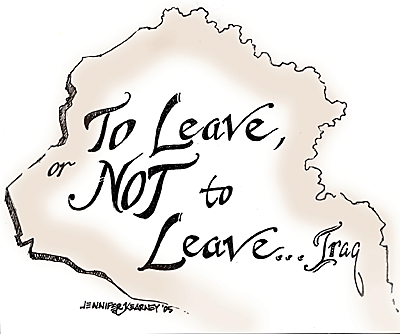
Illustration by Jennifer Kearney
|
|
By Mike Morefield
Arizona Daily Wildcat
Friday, November 4, 2005
Print this
The Iraq war has raised questions about war atrocities, the Geneva Convention and urban warfare. It has brought into question the ability and training of our soldiers and their ability to fight isolated insurgents in urban environments, which many say is the new battlefield. No longer will lumbering tanks lined in rows face off against their Soviet counterparts.
These are all issues that have been brought to the front of the news, brought to the people who can solve problems. But there is one issue that has been pushed aside: Iraq has become a training ground for terrorists to hone their skills. The main exports of Iraq will not be oil; it will be trained terrorists.
During the Soviet invasion of Afghanistan, mujahedeen "soldiers" supplied by the U.S. were trained to use small arms, explosives and taught guerilla tactics. These same people are using those skills in Iraq to kill U.S. soldiers, and now they have a new war in which to recruit and train new fighters.
The Pakistani government has hinted that foreigners trained in explosives perpetrated the bombings in Pakistan. Although the likelihood that they were from Iraq is low, the exportation of trained bomb makers and guerillas will expand when the insurgency in Iraq is finally controlled.
The war in Chechnya is a perfect example of how a long insurgent war allows terrorists to practice the art of killing. As the war continues, Chechens are creating more ingenious battle tactics, attacking buildings more precisely. The coordinated hijacking and bombing of two planes and the hostage situation of a Russian school are indicative of the expertise and experience gleaned from an earlier takeover of a Russian opera house.
These soldier-terrorists have spent the time in the trenches to become highly functioning weapons of destruction, and that same tenacity to improve and kill with higher skill is being seen in Iraq.
The roadside bombs and improvised explosive devices are more intricate and more inventive. Soldiers are constantly on guard for anything when in convoys because the terrorists have become so adept at placing bombs and staging ambushes. This forest of mirrors for soldiers can be solely attributed to the advancement in deadly attacks.
The Iraqis originally placed bombs in bags, but soldiers began to recognize them. To combat this, insurgents placed bombs in trashcans, under road kill and used children to block convoys. The terrorists are able to adapt more quickly now than at the beginning of the war, further fueling the argument that exporting terrorism is Iraq's new economy.
When insurgents are either beaten or choose to not fight anymore, they do not simply return to their 9-to-5 jobs or pick up their plows. They will export themselves to other conflicts or areas of terrorism. These will be the new terror cells, and the effects will be more devastating than possible to imagine.
New waves of bombings in cities around the world could spread, made by experts trained in the back alleys of Basrah. Elements of guerilla warfare, like booby traps and hidden weapon caches, will feed stand-alone cells of terrorists in places like Rome and New York. These skills, learned in the Sunni triangle, could create a new wave of catastrophic strikes.
After the Cold War, the world realized it was no longer fighting a dragon like the Soviet Union, but a pit of snakes, isolated cells of highly trained terrorists who blend into societies with ease. These cells will have been trained on the Iraqi battlefield, much like the Taliban fighters that fought against the Soviet Union and later turned on us. The longer the war continues, the more guerrilla warriors will be produced.
The U.S. will be sorely mistaken if it believes that the war in Iraq will slow the war on terror. It will only propagate it, forcing cells to go underground even further. This time, though, they will be trained, experienced and holding a grudge.
Mike Morefield is a political science senior. He can be reached at letters@wildcat.arizona.edu.
